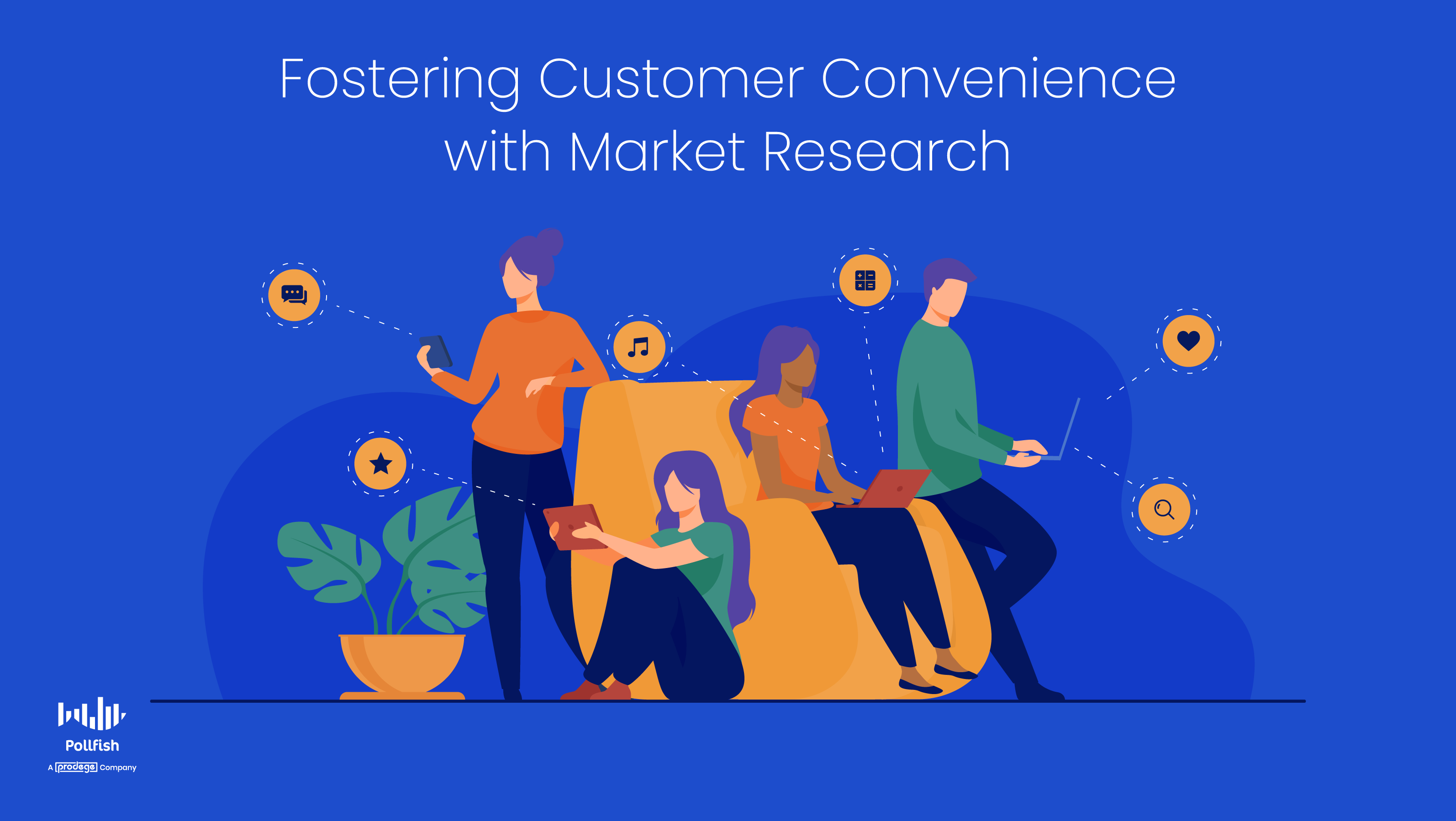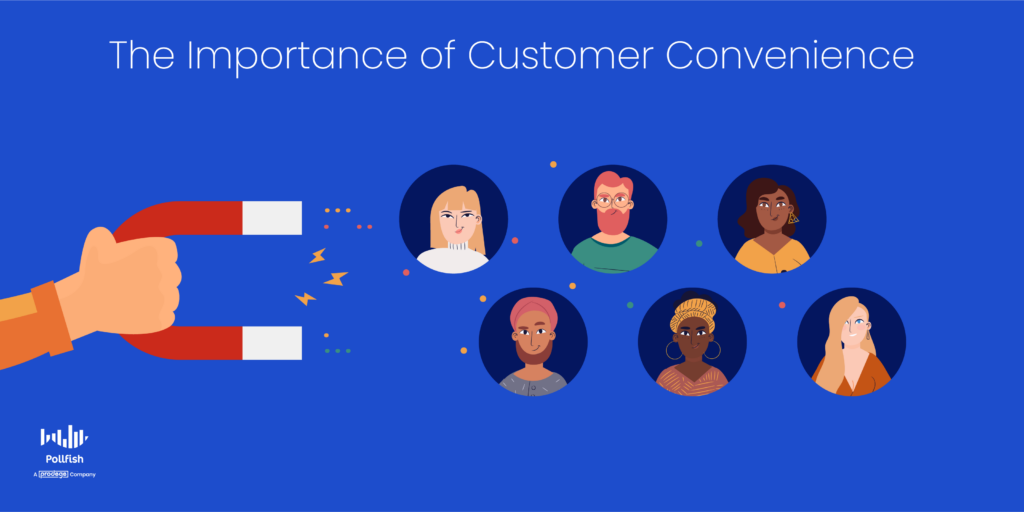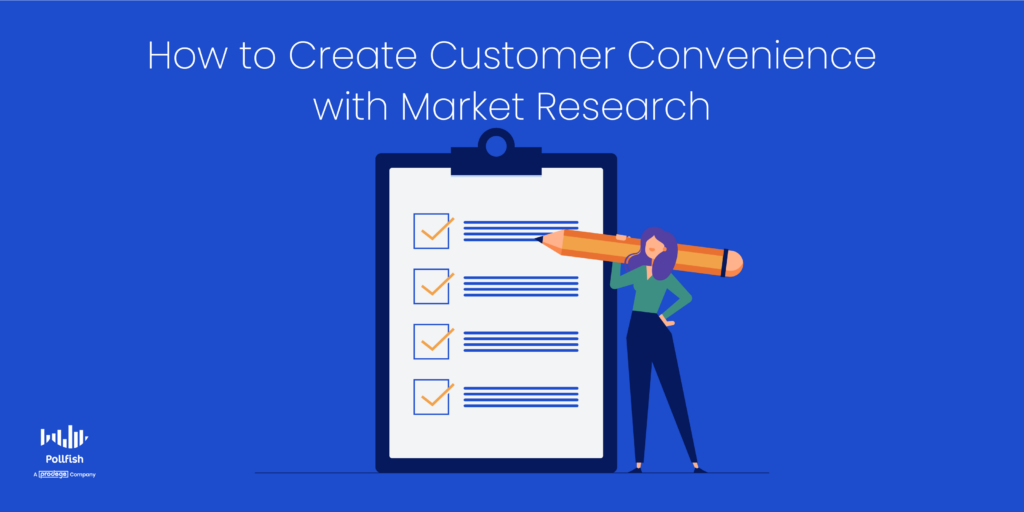Producing Customer Convenience with Market Research

Despite the generality of its name, you should never ignore customer convenience, as you’re not competing on product and price alone. Customers seek convenience wherever they can find it and they strongly value it in the age of ecommerce.
In fact, 83% of customers rate convenience while shopping as more important to them now compared with five years ago. It is clear to see why customers will choose one brand over another, given the weight of the convenience factor.
On the contrary, an inconvenient customer experience will drive customers away from your business — this isn’t an exaggeration. 97% of customers have abandoned a purchase because the service wasn’t convenient enough.
Convenience is the mainspring of the growth of ecommerce; businesses should therefore work towards developing in all parts of their business.
This article explains customer convenience, its importance, common places to include it and how you can produce it with market research.
Understanding Customer Convenience
Customer convenience may outwardly appear to be a broad term. However, despite that it comes in many forms, customer convenience is bound by the concept of easing all customer-facing activities so that it is painless for customers to do business with a company.
Customer convenience does not merely entail making it slightly easier to buy products from a business. Instead, it involves creating ultimate ease across the entire customer buying journey.
Customer convenience involves making any element in the customer experience, including the digital experience, saving customers time and effort. Although many products, services and other offerings were designed and marketed for their convenience, not all areas of business offer it.
What Determines Customer Convenience
This concept is determined by the ratio of pleasure and pain in the user experience, which in turn, affects customer behavior. The more glaring and latent obstacles customers undergo while engaging with your business, the less convenience your business offers. On the other hand, the more friction-free and seamless your processes are, the greater your customer convenience becomes.
Consider all the interactions and undertakings involved with your business that customers face. Are they all designed with ease of use, speed and general convenience? Chances are, with all the campaigns you’re running, that not every customer-facing facet of your business is optimized to save your customers time and effort.
Given that customers prioritize convenience, your brand should too.
The Importance of Customer Convenience
Customer convenience is important for several reasons.
As the intro mentioned, close to 100% of shoppers value customer convenience. This is even more pronounced by the fact that more than one-third of shoppers feel they have less free time now compared with five years ago. These shoppers seek out businesses that help them save their time and effort.
52% of those shoppers say that half or more of their purchases are influenced by convenience. As such, these statistics prove the importance of customer convenience, as it influences purchases and customer buying behavior. Customers are more inclined to buy from businesses that offer convenience, whether it is retailers offering various sizing options, or several delivery options.
As such, customer convenience affects how customers make buying decisions, including what products to buy, what services to get and with which businesses to engage with. Businesses should thus cater to any convenience-related whims and expectations that customers may have.

To achieve this end, they should remove any pain points or causes of discomfort across their customer experience. This involves digitally, physically and across various other customer touchpoints, such as on the one.
When it is easy for customers to get the information they need and to complete a purchase with you, not only will they be more inclined to buy from you, they’ll also be happier, owing to the convenience you provided. As such, convenience is a vital factor in customer satisfaction.
Satisfaction is a key factor in patronage and when customers are constantly satisfied, then you’ll earn their loyalty, which in turn yields customer retention and finally, customers with a high Customer Lifetime Value (CLV). Building up to the status of a high CLV requires the starting point of delivering customer convenience.
As such, creating customer convenience is a necessary long-term strategy for growing your business.
Common Ways to Create Customer Convenience
To reiterate, customer convenience exists in many forms. You should forge customer convenience whenever possible, not just during a transaction or a point of sale. This is because it exists in five dimensions of service: time, place, acquisition, use, and execution.
Aside from service, there are also several other key instances in the customer experience that require establishing customer convenience. These involve various marketing and UX concepts.
The following lists the various common ways you can use to create customer convenience, along with examples on how to create convenience in each category:
- Usability
- This involves the core of convenience, referring to the ease of using something.
- This can involve using the product, a service, or a digital experience,
- Digital experiences involve digital products, content and mechanisms for ordering, purchasing or subscribing to something.
- Example: Create convenience in the checkout with a one-click purchase capability
- Location
- Create products and services close to the customer or that the customer can access quickly.
- For example: advertising to a target market segment that lives near the location of your shop or where your products/services are sold.
- Create products and services close to the customer or that the customer can access quickly.
- Saving Time
- Saving time is one of the major components of customer convenience. No one likes having too much of their time taken up, not least by interacting with a business.
- Assure your website, mobile site and apps quickly load.
- Create a quick checkout and agility in all of your digital experiences.
- Personalization
- Personalize everything to show customers you understand them and don’t merely offer generic communication.
- Use marketing personalization in all of your marketing, outreach and communications practices.
- Make sure to customize your marketing content, as well as your products to your target market’s liking.
- Example: an online service or machine with menus that customers can use to personalize their experience.
- Scheduling
- This involves arranging appointments, meetings, repairs, calls with customer support and even conducting market research at times most convenient for your customers, or, in the case of market research techniques, your respondents.
- Offer various scheduling options, include custom scheduling, so that your customers choose the exact time and date of their appointments, etc.
- Delivery
- Always offer delivery services to your target market
- Ensure you offer delivery to all neighborhoods of a city, not just the main ones.
- There are various restaurants and food service businesses, for example, that only deliver to Manhattan, but not other boroughs.
- Offer various delivery options.
- This involves expedited delivery and contactless delivery options.
- Portability
- This refers to mobility and the ease of carrying items around.
- To remain competitive, create items that weigh less, are more compact and are easy to carry.
- For example, air conditioners are known for being unwieldy; you can keep your business competitive by making them portable.
- Automation
- This involves computers and software performing work that a human would otherwise do.
- When it comes to market research, this includes using a provider that runs on artificial intelligence.
- Certain products for everyday use can also be automated, for example, a dishwasher, soap dispenser, etc.
How to Create Customer Convenience with Market Research
Market research opens doors to your customers, from being able to segment your customers with market segmentation, filtering them further by creating customer personas and studying them for various campaigns.
Since customer convenience is centered on the customers, gleaning insights from the customers themselves is the most ideal way to produce it. Market research brings you these insights and the fastest and most convenient way to reach these insights is through conducting a survey campaign.
When you apply custom research, as opposed to syndicated research, you are entirely in control of your market research campaign. You’ll be able to create surveys by extracting the exact target audience you need, build your own questionnaires and qualify respondents on categories that go far beyond age and gender.

When creating your questions, you’ll be able to quiz your customers on a host of convenience-related matters. The surveys you create will uncover a host of customer intelligence, including consumer preferences on various aspects of your business.
This grants you firsthand insights into how your target market defines customer convenience for itself. By understanding your customers’ preferences, wants, needs and opinions, you’ll be able to inject convenience across all areas of your business, from the workings of your products, to customization, to UX and much more.
Here are a few key ways to create customer convenience through market research:
- Use a reliable online survey platform to complete the following steps.
- Begin by segmenting your customers via market segmentation using an online survey platform.
- You can create as many segments and subsegments as necessary for your campaigns.
- Create customer personas for granular representations of your actual customers.
- Survey your customers on customer satisfaction to discover gaps in your service, communications and overall CX.
- They will provide opportunities to improve your offerings and forge convenience.
- Create surveys with themes from the prior section on the common ways to produce customer convenience.
- To learn how difficult it is for your customers to interact with your company with the Customer Effort Score or CES survey.
- This shows the degree of difficulty a customer has experienced to try to get an issue resolved. It also refers to the ease (or difficulty) a customer had with a certain touchpoint with a company.
- Create campaigns to improve the gaps and points of friction you discovered from doing survey research in Step 3.
- You may want to conduct causal research and experimental research to determine if your changes correspond with customer happiness and truly hammer out convenience.
- Probe further by creating effective surveys on the campaigns you’ve created in Step 4.
- Here, you should assess the effects of the changes you’ve made and whether they’ve been able to foster customer convenience.
- Iterate what customers find convenient and remove all areas of difficulty that you discover from your survey studies.
- You can create follow-up surveys to continue optimizing your customer convenience.
Keeping Your Customers Comfortable at all Times
The way to stay ahead of the competition is to keep customers returning to you as opposed to patronizing your competitors. In order to stimulate customer loyalty and this kind of retention, you’ll need to produce customer convenience whenever possible.
Market research provides an avenue for creating customer convenience, as it involves studying your customers to understand them at a deep level. Given that convenience can exist in many forms, market research allows you to understand which are preferred by your customers, as well as what they find inconvenient in their customer experience.
In this way, customer convenience serves as the antidote to customer attrition, allowing you to keep more customers happy and most importantly, retain more customers. To do so, you’ll need to use a strong market research platform.
Such a platform should run on random device engagement (RDE) sampling, allowing you to reach customers in their natural digital environments, instead of pre-recruiting them. This removes social pressures and will cut back on biases.
You should also use a mobile-first platform, as mobile dominates the digital space and no one wants to take part in a difficult mobile session.
The platform you opt for should also offer artificial intelligence and machine learning to remove low-quality data, offer a broad range of survey and question types and disqualify low-quality data.
It should also allow you to survey anyone. As such, you’ll need a platform with a reach to millions of consumers, along with one that offers the Distribution Link feature.
This feature will allow you to send your survey to specific customers, instead of just deploying them across a network.
With an online survey platform with all of these capabilities, you’ll be able to extract quality customer data and forge customer convenience at every turn.
Pollfish Marketing Team
Ready to Try Pollfish?
Create your survey with AI, target high-quality respondents starting at $0.95 per complete, and start getting results in just minutes in real-time. From running a simple product concept survey to managing a constant stream of trackers for dozens of clients in dozens of countries, we’ve got you.
